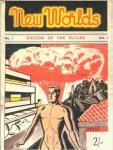AustLit
Latest Issues
AbstractHistoryArchive Description
The complicated publishing history of this influential British science-fiction magazine began in 1936, when Maurice K. Hansen began a fanzine called Novae Terrae (Latin for 'new worlds'), which ran for twenty-nine issues before Hansen, finding the project too time consuming, handed it over to editor John Carnell. Carnell re-named the publication New Worlds, and restarted the numbering system. This version of the publication ended in 1939 with the outbreak of World War II, after only four issues.
Carnell restarted the periodical in 1946, publishing it as New Worlds, with the subtitle "Fiction of the Future.' Under his editorship the magazine ran for nearly twenty years and held a monthly publication schedule from 1954. In 1963, Carnell decided to close the magazine, but the intervention of fan and writer Michael Moorcock instead saw it sold to publishers Roberts & Vinter, with Michael Moorcock established as editor from 1964.
New Worlds went into receivership in 1967, but returned after a brief hiatus, thanks to an Arts Council grant. This version lasted only four years, before folding in 1971. Revived again (again by Moorcock) in 1971 as an anthology paperback called New Worlds Quarterly, the magazine couldn't sustain the quarterly publication schedule and folded after ten issues (in 1976).
Since then, New Worlds has been revived as a semi-prozine in 1978 (which folded in 1979, after five issues) and as an annual trade paperback in 1991 (which folded after four issues plus one-off issues in 1996 and 1997).
According to Mike Ashley,
'From this fourth issue [of the post-war revival version], New Worlds started to develop its own character. It was sufficiently different from its American counterparts to be distinctive. Although its size, format and policy echoed Astounding, there remained a typically British atmosphere about it. The covers were subdued, thus making them more appealing to the general reader rather than the more juvenile elements who were attracted by the brash action covers of most 1940s American pulps. It is almost certain that the average age of readers of New Worlds, as with Astounding, was older than that of readers of the other sf pulps. The stories also had a strong British flavour.' (The Time Machines: The Story of the Science-Fiction Pulp Magazines from the Beginning to 1950, Liverpool University Press, 2000, p.205.)
Notes
-
- First published as New Worlds in 1939.
- Revived in 1946 as New Worlds, with the subtitle "Fiction of the Future."
- In 1953 (Vol 7, No 20), the magazine adopted the title New Worlds
Science Fiction, retaining this through until Vol 48, No 148 (1964), at
which time the term 'Science Fiction' was replaced by 'SF."
- In 1965 (Vol 49, No 151) the title was reduced back to simply New Worlds. The words 'compact' and "sf' were included on the cover next to the magazine's new logo. It continued to be published as New Worlds through until 1971.
- Volume 50, numbers 171 (March) and 172 (April) 1967 were published as New Worlds and SF Impulse. The merger between the two magazines ended when New Worlds went into receivership.
- Volume 51, numbers 173 (July) to 177 (November) 1967 were published as New Worlds Speculative Fiction.
- From issue No 202 (1971), the magazine was published as New Worlds Quartely.
- "Quarterly" was dropped in 1973, with No 207 being the start of a publishers series. The first edition of this kind, titled New Worlds 6, followed on from New Worlds Quarterly 5 (No 206).
[For further details see the "New Worlds" entry published inline by Galactic Central Publications]
Publication Details of Only Known VersionEarliest 2 Known Versions of
Works about this Work
-
The Journeys They Took
2005
single work
criticism
— Appears in: Tirra Lirra , vol. 14 no. 2 2005; (p. 27-31) Scratch Pad 57 , January 2005; (p. 8-11)
— Review of The Best Australian Science Fiction Writing : A Fifty Year Collection 2004 anthology short story novella -
The Golden Age of Australian Science Fiction
1995
single work
column
— Appears in: Science Fiction : A Review of Speculative Literature , vol. 12 no. 3 (Issue 36) 1995; (p. 3-28)
-
The Golden Age of Australian Science Fiction
1995
single work
column
— Appears in: Science Fiction : A Review of Speculative Literature , vol. 12 no. 3 (Issue 36) 1995; (p. 3-28) -
The Journeys They Took
2005
single work
criticism
— Appears in: Tirra Lirra , vol. 14 no. 2 2005; (p. 27-31) Scratch Pad 57 , January 2005; (p. 8-11)
— Review of The Best Australian Science Fiction Writing : A Fifty Year Collection 2004 anthology short story novella
PeriodicalNewspaper Details
Has serialised
-
The God Killers
The Off-Worlders,
single work
novel
science fiction
'Adventure on a backward farming-society world where the old science is forbidden'. (Source: 'Science Fiction by Australians 1960-1970').




